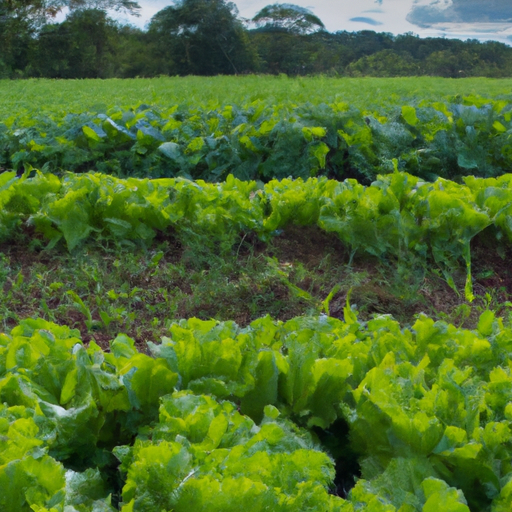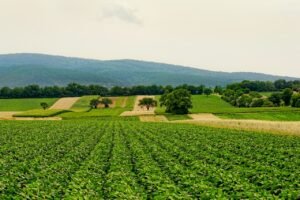
Imagine a world where agriculture thrives without the use of synthetic pesticides or genetically modified organisms, a world where nutrient-rich soil and biodiversity take center stage. Organic farming, with its emphasis on sustainable practices, seems to hold the key to this future. But is organic farming truly the path we should be taking? In this article, we will explore the merits and potential drawbacks of organic farming, and delve into whether it can indeed revolutionize the future of agriculture. So, buckle up and get ready to discover the intriguing world of organic farming.
Introduction
Welcome to the world of organic farming! In this article, we will explore the countless benefits of choosing organic farming methods, the challenges faced by organic farmers, the role of organic farming in sustainable agriculture and climate change, the growing consumer demand for organic products, the government policies and support for organic farming, the various techniques employed in organic farming, successful organic farming practices, and the economic viability of organic farming. So, let’s dive in and discover why organic farming is considered the future of agriculture!
Benefits of Organic Farming
Reduced Chemical Exposure
One of the primary advantages of organic farming is the minimized exposure to synthetic chemicals. By eliminating the use of chemical fertilizers, pesticides, and herbicides, organic farmers provide a safer working environment for themselves and their workers. Moreover, choosing organic products reduces your own exposure to harmful chemicals and helps protect the overall health of the ecosystem.
Improved Soil Quality
Organic farming practices focus on building and maintaining healthy soil. By using natural methods such as composting, crop rotation, and cover cropping, organic farmers enhance soil fertility, structure, and moisture retention. This leads to improved soil health, increased microbial activity, and ultimately, higher crop yields and nutrient density.
Higher Nutritional Value
Research indicates that organic crops often possess higher levels of vitamins, minerals, and antioxidants compared to conventionally grown crops. These nutrient-rich foods can contribute to better overall health and well-being. Furthermore, organic livestock is raised on organic feed without the use of antibiotics, growth hormones, or genetically modified organisms (GMOs), resulting in meat, dairy, and eggs that are free from potentially harmful substances.
Supporting Biodiversity
Organic farming methods prioritize the preservation of biodiversity by protecting natural habitats, creating diverse and balanced ecosystems, and avoiding the use of genetically modified organisms. By providing a suitable habitat for a wide range of organisms, including helpful insects, birds, and soil microorganisms, organic farms contribute to the overall resilience and health of the surrounding environment.
Challenges of Organic Farming
Lower Yields
One of the significant challenges faced by organic farmers is often lower crop yields compared to conventional farming practices. Organic farming relies primarily on natural fertilizers and pest control methods, which may require more time for soil restoration and managing pests without chemicals. However, with careful planning, implementation of effective organic techniques, and continuous innovation, organic farmers can achieve yields comparable to or even surpassing conventional methods.
Price Premium
While organic products provide numerous benefits, they often come with a higher price tag. The higher production costs associated with organic farming, including manual labor, certification fees, and increased management requirements, contribute to the price premium. However, as organic farming continues to gain popularity and economies of scale improve, the price gap is narrowing, making organic products more accessible to a broader range of consumers.
Transition Period
Transitioning from conventional to organic farming methods can be challenging for farmers. It takes time to restore soil health and adapt to new techniques and regulations. During the transition period, farmers may face lower yields and financial uncertainty. However, with proper guidance, training, and support networks, farmers can successfully navigate this transitional phase and reap the long-term benefits of organic farming.
Certification Process
To ensure transparency and maintain consumer trust, organic farmers must go through a rigorous certification process. This process involves adhering to strict standards set by regulatory bodies and obtaining periodic inspections. While certification provides credibility and allows organic farmers to access organic markets, it can be a time-consuming and resource-intensive process for farmers, especially small-scale producers. Streamlining the certification process and reducing the associated costs can encourage more farmers to embrace organic farming practices.
Sustainable Agriculture and Climate Change
Reducing Greenhouse Gas Emissions
Organic farming plays a vital role in mitigating climate change by reducing greenhouse gas emissions. By avoiding the use of synthetic fertilizers and focusing on organic soil management practices, organic farmers prevent the release of nitrous oxide, a potent greenhouse gas. Additionally, organic farming methods promote healthier soils, which can sequester carbon dioxide from the atmosphere, helping to offset emissions and combat climate change.
Protecting Water Resources
With its emphasis on natural pest and nutrient management, organic farming practices help minimize water pollution. By avoiding the use of synthetic pesticides and fertilizers, organic farms reduce the risk of chemical runoff contaminating water sources. Furthermore, organic farmers typically implement water conservation techniques, such as mulching and drip irrigation, to minimize water usage and preserve precious water resources.
Adapting to Extreme Weather Events
Climate change brings an increased frequency and intensity of extreme weather events, posing significant challenges to agriculture. Organic farming, with its focus on building resilient ecosystems and diverse crop rotations, provides a better chance of adapting to these changing conditions. By enhancing soil health and biodiversity, organic farms are less susceptible to drought, flooding, and pest outbreaks, increasing their long-term sustainability and reducing the vulnerability of farmers to climate-related risks.
Consumer Demand for Organic Products
Growing Market
The demand for organic products has been steadily increasing over the years. Consumers are becoming more aware of the potential health and environmental hazards associated with conventional farming methods and are actively seeking organic alternatives. This growing market provides opportunities for organic farmers to expand their operations and gain wider recognition for their sustainable practices.
Health and Environmental Consciousness
Consumers are increasingly concerned about the impact of their purchasing choices on personal health and the environment. By choosing organic products, consumers can support a healthier lifestyle and minimize exposure to potentially harmful chemicals. Organic farming methods are also aligned with eco-friendly practices, reducing environmental damage and promoting sustainable agricultural systems. The rising consciousness among consumers regarding these issues has been a driving force behind the increased demand for organic products.
Government Policies and Support
Subsidies and Incentives
Governments around the world are recognizing the significance of organic farming and offering various subsidies and incentives to promote its adoption. These include financial support for organic certification, grants for research and development, subsidies for organic inputs, and assistance programs for farmers transitioning to organic practices. Government support can help alleviate some of the financial burdens associated with organic farming and encourage more farmers to embrace sustainable agricultural methods.
Regulations and Standards
To maintain the integrity of the organic label and protect consumer confidence, governments enforce regulations and standards for organic farming. These guidelines ensure that organic products meet specific criteria regarding production methods, labeling, and inspection. Adhering to these regulations helps establish a level playing field for organic farmers, promotes fair trade practices, and assures consumers of the authenticity and quality of organic products.
Organic Farming Techniques
Crop Rotation and Intercropping
Crop rotation and intercropping are essential techniques employed in organic farming to promote soil health and combat pests and diseases. By rotating crops in a planned sequence, farmers break pest and disease cycles, prevent nutrient depletion, and improve soil structure. Intercropping, which involves growing different crops together, provides additional pest control, enhances soil fertility, and maximizes land utilization.
Composting and Vermicomposting
Composting is the process of converting organic waste materials, such as crop residues and animal manure, into nutrient-rich compost. This organic fertilizer enriches the soil with essential nutrients, improves soil structure, and enhances moisture retention. Vermicomposting, a specialized form of composting using worms, accelerates the decomposition process and produces high-quality vermicompost, which is highly beneficial for plant growth.
Natural Pest and Weed Control
Organic farmers utilize various methods to control pests and weeds without the use of synthetic chemicals. These include: introducing beneficial insects and birds that feed on pests, using natural repellents and traps, employing physical barriers, and practicing mechanical weed control techniques such as hand-weeding and cultivation. Integrated Pest Management (IPM) strategies are also commonly utilized, utilizing a combination of techniques to manage pest populations effectively.
Biological Control Agents
Biological control agents, such as predatory insects, parasites, and nematodes, are crucial components of organic pest management. These beneficial organisms prey on pests and help maintain a natural balance in the ecosystem. By introducing and conserving these natural enemies, organic farmers reduce their reliance on chemical pesticides, minimize environmental impact, and allow for the long-term suppression of pests.
Successful Organic Farming Practices
Case Studies
Numerous successful case studies demonstrate the viability and potential of organic farming. From small-scale urban organic farms to large-scale rural operations, these examples showcase innovative organic farming techniques, market strategies, and community engagement initiatives. These case studies serve as inspiration and learning opportunities for aspiring organic farmers, highlighting the diverse paths to success in this field.
Best Practices
Organic farming relies on a combination of scientific knowledge, practical experience, and continuous learning. It is essential for organic farmers to stay updated with the latest research, attend training programs, and actively engage in the organic farming community. Sharing best practices and experiences with fellow farmers fosters knowledge exchange and promotes the adoption of effective organic farming techniques, leading to improved productivity and sustainability.
Economic Viability of Organic Farming
Cost Analysis
Determining the economic viability of organic farming involves analyzing both costs and returns. While organic farming may initially entail higher production costs, especially during the transition period, long-term benefits such as healthier soils, reduced input requirements, and increased market demand can lead to improved profitability. Detailed cost analysis, including factors such as labor, input costs, and market prices, is crucial to understanding the financial feasibility of organic farming.
Market Price Comparison
Organic products often command higher market prices compared to their conventionally produced counterparts. The premium prices reflect the additional costs associated with organic farming, the limited supply, and the perceived value associated with organic products. Farmers considering organic farming must carefully evaluate market dynamics, price premiums, and potential marketing channels to ensure a fair return on their investment.
Conclusion
Organic farming offers a multitude of benefits, ranging from reduced chemical exposure and improved soil quality to supporting biodiversity and mitigating climate change. While challenges such as lower yields and a price premium exist, the growing consumer demand for organic products, government policies, and the implementation of successful organic farming practices contribute to the economic viability and long-term sustainability of organic farming. By adopting organic farming methods, we can embrace a more environmentally friendly and health-conscious future for agriculture. So, go ahead and take the leap into organic farming – you’ll not only reap the benefits but also play an important role in shaping the future of agriculture for generations to come.







